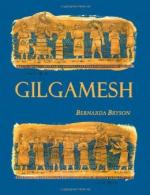|
This section contains 400 words (approx. 1 page at 400 words per page) |

|
Gilgamesh: Man's First Story Summary & Study Guide Description
Gilgamesh: Man's First Story Summary & Study Guide includes comprehensive information and analysis to help you understand the book. This study guide contains the following sections:
This detailed literature summary also contains Further Study and a Free Quiz on Gilgamesh: Man's First Story by Bernarda Bryson Shahn.
It could be argued that any story more than four thousand years old deserves the close attention of modern students of literature. The appeal of this epic, however, goes far beyond its literary antiquity. Gilgamesh abounds with drama, conflict, and charismatic characters, and its topics are many and varied.
These include such enduring human concerns as the fear of death, the need for true friendship, the importance of achieving great deeds and displaying virtuous traits (such as courage, loyalty, and leadership) and—perhaps most vital of all—the glory and wisdom to be found in the search for truth. On a basic human level, the narrative reveals many ways in which these ancient peoples differed from modern humans, but also points to surprising similarities. Some scholars may quarrel with Bryson's claims that this is "man's first story," but there can be no question that Gilgamesh is the world's first genuine epic hero.
A number of later epic and legendary heroes—including Odysseus, Aeneas, and Beowulf—resemble Gilgamesh, and it is thought that some of them were at least partly based on his character. Certain biblical narratives, most notably the story of Noah and the Flood, may also have been based on episodes from this epic. Scholars are not in total agreement, but there is a strong likelihood that the composers of the Old Testament were familiar either with Gilgamesh or its sources, the oldest of which probably existed in an oral tradition.
Bryson's version relates the story in a straightforward and clear manner. In her "Explanation" at the close of the text, she writes that she has not tried to retranslate the work, which has been rendered into English by several scholars, nor to compile a series of readings of the original. Rather, she has retold the story in an accessible fashion so that today's readers can appreciate it.
Several confusing and inconsistent elements of the original have simply been omitted. And in a few passages, a clarifying transition has been provided. The result is a coherent narrative that faithfully communicates the tone of the story.
Of further interest in this version are the realistic, colorful illustrations— seventy-five of them—that accompany the text. Many are based on archeological evidence and give a sense of the folkways of the people of that era and an impression of the appearances of their gods.
Read more from the Study Guide
|
This section contains 400 words (approx. 1 page at 400 words per page) |

|



